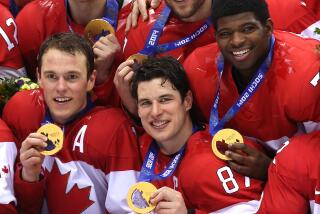Nowadays, Outrage Is as Quiet as a Zamboni
The loneliest man in Los Angeles sticks a key into the wall.
“Want to see it?” he says, and turns the key before you can answer.
Up rumbles a giant metal door and there it sits, his love, his loss, his pain.
His Zamboni?
“Seriously,” Luis Vizcaino says. “This hurts my heart.”
Vizcaino has driven the giant ice resurfacing machine for the Kings for 18 seasons, as many as a dozen times a day.
This winter he hasn’t been on it more than five times.
Vizcaino is used to hearing children pleading for waves, adults begging for rides, the peculiar buzz that surrounds one of the unique jobs in sports.
This winter, he works mostly in silence.
Sometimes he opens the Staples Center garage and starts the Zamboni machine just to hear it run.
“Hockey fans are different than other fans,” Vizcaino says, tapping his heart twice.
“Hockey fans feel it in here.”
And where do hockey players feel it? Ignoring the nutty passion of a niche sport because they want to make more money than the average guy playing in the Super Bowl?
The NHL players -- tap your head twice -- have nothing up there.
Their season has been lost, and it’s their fault. Their sport has been crushed, and it’s their footprints.
It was the NHL owners who bolted the door last September and will not open up until there are salary restraints.
But it is the players who are looking at the situation as if clouded by funny masks and broken noses.
So they consider themselves participants in a major professional sport that justifies a $1.8-million average salary?
Then why, since the lockout, has it been quiet enough to hear a puck drop?
Where, in the economic center of the league known as the United States, is the outrage?
Why have ESPN’s ratings during former hockey time slots actually improved? With sports like jump roping?
Where are the fan protests? Where is the media blitz? Where are the sporting goods managers griping that hockey jersey sales have declined 85%?
Is it because they never sold that many to begin with?
And where, oh where, are the e-mails?
I generally receive about 200 e-mails per outrageous sports act, more if it involves Kobe Bryant or Milton Bradley.
About hockey this winter, I’ve received two.
“That’s the really weird thing about it,” says Luc Robitaille, the King star. “Nobody is talking about it. Nobody.”
Completely misjudging the market, hockey players gave America the chance to learn to live without them.
America shrugged, turning its lonely eyes to the World Poker Tour.
That the players haven’t come sliding back to work shows they have less common sense than teeth.
Emphasizing that he was speaking strictly as a fan, Robitaille sighs.
“It’s horrible for the game,” he says. “It’s killing the game.”
There is talk, as always during sports labor spats, that the owners are cooking the books.
But you can see these numbers even more clearly than the puck.
Hockey’s TV ratings are so lousy, its new contract with NBC is a revenue-sharing deal, other sports receiving billions while hockey gets a handshake.
Hockey’s attraction is so spotty and its costs so high, one-third of the league’s teams can’t fill their arenas.
Hockey’s game has become so plodding and defensive, average folks can’t watch until the playoffs, and then turn away after sitting through five hours of a scoreless tie.
So the owners, who admittedly caused many of these problems, want a change in the game’s economics?
The players don’t have a blade to skate on.
“The players are following their leadership,” says Tim Leiweke, King president. “And that’s unfortunate.”
Their leader, a guy named Bob Goodenow, makes Donald Fehr seem like Einstein.
He doesn’t realize that in most of this country, hockey is much like its beloved Zamboni.
Funky, cool, but an acquired taste.
The Kings have this city’s most passionate professional sports fans. But they also have the fewest.
Those 18,000 who fill Staples Center every night? That about does it.
Laker championship parades are attended by hundreds of thousands who have never been to Staples Center. Would a King parade be attended by anybody who hasn’t?
The players are demanding Fortune 500 salaries when, in fact, they work in a boutique.
The hottest thing on ice has become the Arena Football League on ice.
When the NHL finally does come back to work, the damage wrought will reduce its place on the American sports landscape to somewhere alongside the WNBA.
There are only three major professional sports in this country now. The Big Four is no more.
The NHL players need to realize this and, like every other pro league at some point in its history, accept salary constraints for the survival of the sport.
And, of course, for the return of the Zamboni.
“Many people say it’s their lifelong dream to ride up there with me,” says Vizcaino, who can take one passenger between periods. “It’s fun to see the excitement in their eyes.”
When it does return, if it does return, don’t be surprised if one of the loudest ovations is given to the Zamboni.
After all, it hasn’t spent the last five months trying to convince us it’s a Cadillac.
*
(Begin Text of Infobox)
LOCKOUT GLANCE
*
*Total days: 136.
* Days of season missed: 109.
* Total games missed: 738 of the 1,230 regular-season games plus the 2005 All-Star game.
More to Read
Go beyond the scoreboard
Get the latest on L.A.'s teams in the daily Sports Report newsletter.
You may occasionally receive promotional content from the Los Angeles Times.







